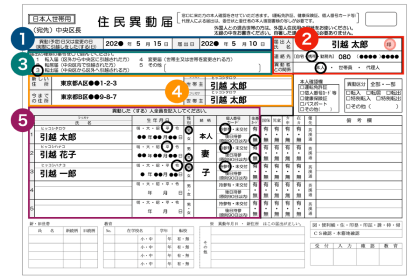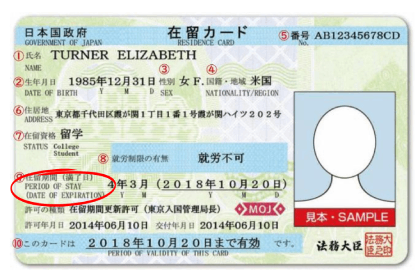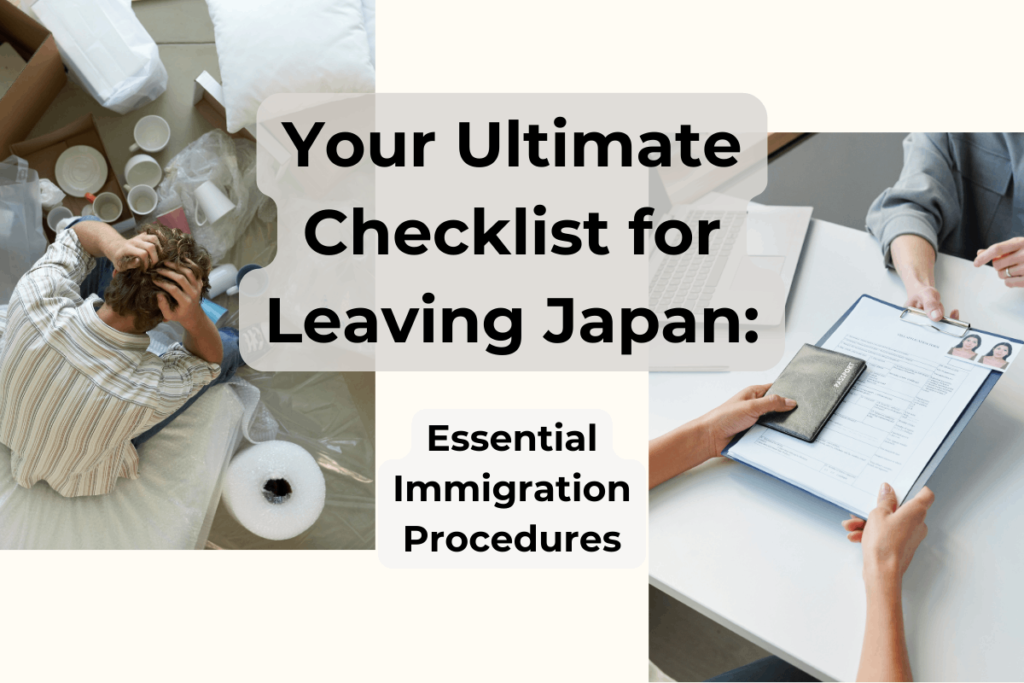Whether you’re being sent abroad by your company or you’re a student taking a gap year, leaving Japan indefinitely can be both exciting and stressful. Figuring out what needs to be on your leaving Japan checklist can often feel overwhelming.
Even after figuring out what needs to be done, dealing with the departure procedures can be one of the most daunting tasks, no matter the country.
To help with these procedures, this article will provide a checklist of everything you might need to do at the Ward Office and Immigration Office, with tips, if you’re leaving Japan indefinitely.

Hello readers! Sakura Mobile is a SIM Wi-Fi service provider for international residents and tourists in Japan.
Our global editorial team living in Japan will introduce the country’s charms based on what we have experienced and felt.
Table of Contents
Ward Office Procedures
Moving Out Form (転出届):

All residents (including foreign residents) are required by law to notify their Ward Office when a change of address occurs.
The 転出届 (tenshutsu todoke) must be filed with your current ward office whether you are relocating to a different city or leaving Japan indefinitely. If you plan to primarily live abroad for an extended period or cancel your contract for your current residence, you will need to fill this out.
To fill this out, bring your:
-
-
- Proof of departure (e.g., flight itinerary, ticket, etc.)
-
- Valid ID (e.g., passport, residence card, etc.)
-
↑ Go back to the table of contents
Health Insurance:
You have two options regarding your National Health Insurance while abroad:
- Continue paying your National Health Insurance premiums while you’re abroad.
- Cancel your National Health Insurance until you return to Japan.
If you choose Option 1, make sure to pay your premiums on time. Setting up automatic bank remittances can help ensure this.
If you choose Option 2, follow these steps:
- After filing your tenshutsu todoke, go to the National Health Insurance window at your ward office.
- Return your health insurance card.
- Settle your health insurance bills.
↑ Go back to the table of contents
My Number Card (マイナンバーカード)

If you have an Individual Number Card (マイナンバーカード), you can return your card at your local Ward Office.
Look for a window labeled マイナンバーカード or ask the information section.
When you return to Japan, the ward or city office will issue the same number to you again.
↑ Go back to the table of contents
Resident Tax:
Even if you plan to leave Japan indefinitely during the middle of the year, you are still required to pay the tax if you were in Japan on January 1st of that year.
If you return to your home country without paying the resident tax, they will still demand the payment even though it is late.
To manage your resident tax while abroad:
-
-
- Designate someone you trust as your tax representative
-
- Your representative will submit your tax return after your pension refund comes through.
-
- They will also handle any taxes due if you leave during the tax season.
-
Your representative must:
-
-
- Be a resident of Japan
-
- Be able to communicate in Japanese with the taxation office
-
- Accompany you to the local tax office to complete the necessary paperwork to designate them as your representative.
-

Make sure to get an estimate on your resident tax at the ward office. This way, you can set aside the funds for your representative to pay on your behalf.
If you’re working in Japan, your tax will be calculated based on the previous year’s income.
↑ Go back to the table of contents
Pension:

If you’re a resident of Japan between the ages of 20 and 59, you are required to contribute to the National Pension System, regardless of nationality.
If you are living abroad for an extended period but you still plan on coming back, instead of making the pension payments, the International Social Security Agreement may cover you. (Check this to make sure this is the case.)
-
-
- Those who are living or working abroad and are paying local social security.
-
- To avoid a dual burden, you are covered by the system of the country where you work
-
- You will only be covered by the system of the country where you work.
-
Read for more information and what category you fall under here.
If you choose to continue paying while abroad, ask your ward office if you can set up automatic bank remittance or pay via credit card.
↑ Go back to the table of contents
Immigration Office:
Re-entry Permit from the Immigration Office:
If you plan to leave Japan indefinitely but still return within the authorized period of your residency status, you should apply for a “re-entry” permit at your nearest Regional Immigration Bureau before you depart from Japan.

Duration of Re-entry Permits:
-
-
- General Residents: Maximum of 5 years
-
- Special Permanent Residents: Maximum of 6 years
-
There are two types of re-entry permits:
- Multiple Re-entry Permit: Can be used several times within the validity period, which is ideal if you plan to leave and return frequently.
- Single Re-entry Permit: Valid for one entry only. You must apply again for a new permit if you return.
You can extend the period of validity:
-
-
- Special Permanent Residents: within 7 years from the date the permit was issued.
-
- Other Statuses of Residents: up to 6 years from the date the permit was issued.
-
Required Documents:
-
-
- Valid Passport
-
- Application form for Extension of Re-Entry Permit
-
- Supporting documents concerning the reason for applying
-
- Residence Card or Special Permanent Resident Certificate
-
- Payment of fees through the purchase of revenue stamps
-
- Single Re-entry Permit: 3,000 JPY
-
- Multiple Re-entry Permit: 6,000 JPY
-
↑ Go back to the table of contents
Check Your Visa Before Leaving Japan Indefinitely:

Before leaving Japan indefinitely, make sure to check the expiration of your visa.
If it expires while you’re abroad, you can apply for an extension of your visa at the immigration office before you leave.
If you return and it has expired, go to your nearest immigration office to apply for a Temporary Visitor Visa.
Should immigration officials find that your visa expired even a few days prior, you can get into trouble and risk facing a permanent ban from re-entering Japan.
↑ Go back to the table of contents
Stay Connected When You Return

Staying connected when you return to Japan is essential.
With Sakura Mobile’s Voice + Data SIM card and eSIM plans, you can suspend your contract instead of terminating it before you leave Japan indefinitely, reducing your monthly bill to just 220 JPY.
To arrange your suspension, simply fill out the “Request Change Plan form before the 25th of the month before you depart from Japan.
Before you return to Japan, select the “Request change plan” form again. This way, you can have peace of mind knowing you’ll be connected when you arrive.
Learn more about our suspension options here.
↑ Go back to the table of contents
Conclusion
Navigating the Ward Office and Immigration Office procedures before leaving Japan indefinitely involves a series of several important steps.
This will include:
- Checking your visa expiration before you start your traveling.
- Submitting the Moving Out form at your Ward Office.
- Managing Health Insurance, pension, and taxes.
- Get your re-entry permit if you plan to return to Japan.
Some of the procedures on the checklist may take longer than you think, so it may be best to allow for at least a month for documents to be processed.
Being informed and organized throughout the process will help ensure a smooth departure from Japan and re-entry whenever you’re ready to return.
Whatever the reason for your time abroad, we hope you enjoy your time away from Japan!
Sakura Mobile offers various long-term postpaid voice and data service plans. Use the link below to find the one that best suits your needs.
LINK: Sakura Mobile Voice + Data Sim

If you’ve completed everything on this list and are wondering if there is more to be done before you leave Japan, stay tuned for our future articles on LEAVING JAPAN INDEFINITELY.
If you are only traveling abroad for a month or less, check out our Short-Term Departure Blog.

